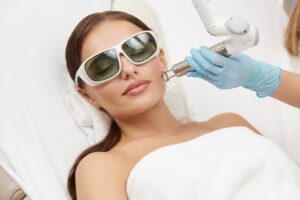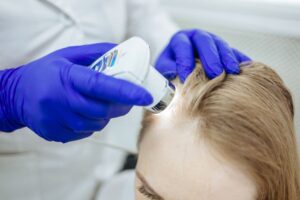A growing number of people are switching up their grooming routine. They’re abandoning traditional razors and electric shavers and heading to clinics that offer laser hair removal. Those who market laser treatments claim that customers see several potential benefits, including smoother skin and a reduction of ingrown hairs.

How Does Laser Hair Removal Work?
Unlike shaving, where a razor cuts the hair shaft that emerges from the skin, clinic technicians train a concentrated beam of light on hair follicles to remove unwanted hair. The light is absorbed by the pigment in the follicle, causing it to burn. The damage to the follicle will inhibit or delay its growth for several weeks or months.
Laser hair removal could create convenience by saving time and money in the long run. However, the results usually aren’t permanent, and the process is costly. Clients must invest in multiple treatments for the initial hair removal process. Afterward, hormone changes and healing follicles often necessitate multiple follow-up sessions. According to the Mayo Clinic, the treatment is most effective for people who have light skin and dark hair, but it can be successfully used on all skin types.
Where Can I Apply Laser Hair Removal Treatments?
Though clinics will avoid the eyebrow area to avoid ocular damage, people can get laser hair removal in many places, such as:
- Upper lip
- Underarms
- Legs
- Chest
- Arms
- Back
- Bikini area
- The edges around your face (baby hairs)
The Med Spa Boom
Laser hair removal is generally considered safe and effective, provided that it is performed by a trained professional. As technology improves and the equipment becomes less expensive and more accessible, the number of medical spa clinics (med spas) has risen significantly in recent years.
These establishments bridge the gap between traditional spas and medical practices, offering a unique blend of non-surgical and cosmetic treatments under the supervision of licensed healthcare professionals. The med spa boom has coincided with the rise of social media. Online influences have affected social norms and expanded the public’s acceptance of cosmetic procedures.
In many ways, the consumer has benefited from the boom, as it has created competition among med spas. Competition drives down prices, and multiple locations allow for flexible scheduling.
What Are The Potential Risks Of Med Spas?

The proliferation of med spas has led to safety concerns, such as:
- A lack of standardization within the industry, regarding the training and qualification of technicians.
- Some clinics employ staff who may not have the requisite credentials, affiliations, and experience necessary for performing sensitive treatments.
- Some clinics may be using outdated or poorly-maintained equipment.
- Some clinics may fail to sterilize equipment, which is crucial to prevent the spread of infections.
The Risks Of Laser Hair Removal
For those who are contemplating a med spa for laser hair removal, there are potential risks to be aware of. Here is a list of some key concerns:
- Skin damage: This is the most common concern, ranging from mild, temporary side effects to more serious issues.
- Pigmentation changes: Laser treatments target melanin, the pigment in both hair and skin. This can lead to hypopigmentation (lighter patches) or hyperpigmentation (darker patches) in treated areas, especially with darker skin tones or improper settings.
- Burns and scarring: In rare cases, high laser energy or operator error can cause burns or even scarring. This risk is higher with darker skin tones, recent tans, or pre-existing skin conditions.
- Blisters and crusting: These usually resolve on their own but can indicate more severe damage or infection.
- Paradoxical hypertrichosis: This is a rare but concerning side effect where laser treatment stimulates unexpected hair growth. The exact cause is unknown, but it’s more likely with certain hair types and laser types.
- Allergic reactions: While uncommon, some individuals may experience allergic reactions to topical anesthetics or other products used during the procedure.
- Severe damage to tattooed skin: The laser does not know the difference between melanin and ink, so if the laser touches your body art, you will be burned badly.
Minimizing Risks With Laser Hair Removal

- Choose a qualified provider: Opt for a board-certified dermatologist or a facility with licensed medical professionals trained in laser hair removal. Check their credentials, experience, and reviews.
- Thorough consultation: Discuss your medical history, skin type, and expectations during a consultation. The provider should assess your suitability for laser treatment and recommend the safest and most effective approach.
- Pre-treatment preparation: Follow all instructions regarding sun exposure, medications, and shaving.
- Proper aftercare: Follow the provider’s guidelines for post-treatment care, including sun protection, avoiding irritants, and moisturizing.
What Should I Do If I Was Injured During Laser Hair Removal?
If you are injured during a laser hair removal procedure, do not hesitate to report any discomfort, unusual reactions, or side effects to a qualified healthcare professional right away, such as a doctor or urgent care clinic. They can assess your injuries, provide treatment, and document your condition for potential future needs. It’s also crucial to report the incident to the clinic where you received the treatment. Document the details of what happened, including the date, time, names of involved individuals, and a description of your injuries. Keep copies of any paperwork you receive, and take pictures of your injuries.
You should also consider reporting the incident to the relevant regulatory body in your area. This will help them investigate the clinic and potentially take action if necessary. Depending on your location, this could be a medical board, consumer protection agency, or similar authority.
Before you sign any agreement with a med spa, review it to see if it includes an arbitration waiver. An arbitration waiver is a clause in a legally binding contract that requires any disputes between you and the med spa to be settled through arbitration instead of traditional court proceedings. This means a neutral arbitrator, not a judge, will make the final decision on your case. These waivers create a power imbalance in favor of the clinic, so customers should beware! Carefully read and understand the implications before signing it.
Finally, consulting with an experienced personal injury attorneys for cases could be beneficial. Here at Allen & Allen, we can review your situation, advise you on your legal options, and potentially represent you if there is a viable claim of negligence against the clinic or technician. Call us for a free and confidential consultation at 866-388-1307.


